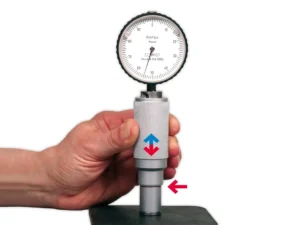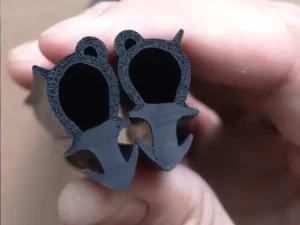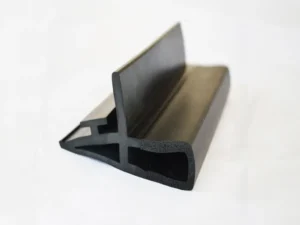We often need rubber seals in our cars, houses, apartments, ships, or even in aircraft. They help seal the gap between cabinets, containers, other enclosures, doors, and windows. They prevent noise, dust, or moisture from entering inside or outside. Dual durometer rubber extrusion is one of the most popular rubber seals.
A dual durometer rubber extrusion has both soft and rigid parts. The following few sections will explain its fundamentals in detail. By reading this article, you will realize why dual durometer rubber is so reliable for a project. Let’s dig in!
What is a Durometer in Elastomer Hardness?

A durometer tells you how hard or soft a rubber is. It checks explicitly how sturdy the rubber is against being pressed into. In other words, the results on a durometer show how stiff or flexible a material is.
The device typically consists of a gauge with a sharp point. It presses into the material to measure its hardness.
The durometer scale typically ranges from 0 to 100. Higher numbers mean more rigid materials, while lower numbers mean softer materials.
Durometer values ensure the material meets the requirements and quality standards.
Understanding rubber shore hardness
You may often find the hardness levels of rubbers in the product specification. However, you might pick the wrong item for your job if you don’t know what they are. So, it’s essential to understand how hard the rubber shore is.
Let’s look at EPDM 60A as an example. EPDM stands for Ethylene Propylene Diene Monomer. It’s famous for being very resistant to weather. On the other hand, the hardness number 60A tells you how stiff the rubber is on the Shore A scale.
Remember that higher values mean the rubber is more rigid, and lower values mean the rubber is softer. EPDM 60A, in this case, refers to a reasonably stiff rubber compound. This kind of rubber works great for gaskets and seals.
What is a Dual Durometer Rubber?

Dual durometer rubber is a unique type of sealing product. It is composed of two different hardness levels of rubber.
If you observe the cross-section of dual durometer rubber, you will see a soft and rigid part. Combining these two parts makes a special rubber seal. This mixture allows soft and rigid materials for the same product.
The soft part of the seal helps in sealing, while the rigid helps in attachment. As a result, it can ensure effective sealing, cushioning, and impact resistance. Because of this, it is suitable for a wide range of applications.
The method used to make this rubber is called co-extrusion. It pushes two different types of rubber into the same die simultaneously. The shape of the die generally determines the shape of the final product.
Why is Dual Durometer Rubber so Reliable?

As was already said, dual durometer rubber has soft and rigid parts. For flexibility and elasticity, softer parts are excellent. They do an excellent job of sealing and cushioning. However, rigid parts have structural support and are more stable. When we put these two parts of a dual-durometer rubber together, we can get the following benefits:
Reason #1 Enhanced Sealing
When the soft and rigid parts are combined, you get better sealing. The rigid part provides a strong attachment, and the soft part ensures the seal works well. Because of this, dual durometer rubbers are often used in harsh environments.
Reason #2 Improved Durability
With a rigid base for attachment and a soft part for sealing, dual durometer rubber offers increased durability. It can resist wear and tear for a long time.
Reason #3 Versatility
Dual durometer rubber profiles offer diversity in both style and function. So they can meet the needs of a wide range of applications. In the long run, you can use them to fit people of many types and sizes.
Reason #4 Cost-effectiveness
Dual durometer rubber seals use both flexible and rigid materials. This structure mainly reduces manufacturing costs. In addition, it doesn’t compromise performance, making the installation cost-effective.
Reason #5 Ease of Installation
Dual durometer rubber extrusions are easy to install. You can save both time and labor during assembly.
Types of Durometers and their applications in rubber industries
Durometer scale rubber has many uses. It’s common to find different durometer levels when looking for rubber seal strips. To pick the right type for your job, you need to know about these types.
There are fourteen different types of durometers. Common types include A, B, C, D, DO, E, and more. Among these, type A and Type D are popular in the rubber industry.
Type A suits softer rubbers, and Type D suits harder rubbers and plastics. They are widely used to measure a wide range of materials accurately.
| Feature | Type A Scale | Type D Scale |
| Indentor Shape | Conical 35° | Conical 30° |
| Application | Suitable for softer rubbers and elastomers | Ideal for harder rubbers and plastics |
| Shore Hardness Range | 0 to 100 | 0 to 100 |
| Typical Material Range | Very soft to medium-hard rubber materials | Hard rubber materials, plastic, rigid elastomers |
| Indentor Tip Diameter | φ 0.79 | R 0.1 |
| Spring Load Value | 56.1 – 821.1 gf | 0 – 4533 gf |
| Test Method | ASTM D2240 | ASTM D2240 |
Popular Applications of Dual Durometer Rubber
The unique design of dual durometer rubber makes it distinctive from other types. Because of this, it is used in a lot of different industries. Dual durometers are very common, primarily for sealing and protecting things. Some common uses for dual durometer rubber are as follows:
This table mainly lists the uses of dual durometer rubbers, what they’re used for, and the names of the individual products.
| Use | Purpose | Specific Product Names |
| Automotive seals | Provide durable and flexible barriers against moisture and noise | Door seals, window seals, weather stripping |
| Construction Industry | Seal gaps, prevent water intrusion, absorb structural movement | Building seals, gaskets, expansion joints |
| Electronics | Cushion and protect electronic components against dust and impact | Enclosure, gaskets |
| Medical devices | Maintain sterile environments, prevent contamination | Medical equipment seals, gaskets |
| Industrial machinery | Ensure reliable sealing and protection against debris and fluids | Hydraulic seals, machinery enclosures |
| Aerospace industry | Withstand extreme temperature fluctuations | Aircraft seals, gaskets, vibration dampeners |
| Marine applications | Provide watertight seals, resistance to saltwater corrosion | Boat seals, hatch gaskets, marine equipment |
| Appliance manufacturing | Prevent leaks, ensure proper operation | Refrigerator seals, washing machine gaskets |
Frequently Asked Questions
How do you test a rubber durometer?
First, ensure the rubber durometer has been correctly adjusted before you test it. Then, place it perpendicular to the rubber surface. Now, apply steady pressure until the gauge needle stops moving. Read the hardness value where the needle points.
You can do it several times for more accurate results. In addition, you can compare readings with the standard chart.
What is EPDM 60 Durometer?
EPDM 60 Durometer is a type of black rubber made by blending EPDM with SBR. This rubber is excellent for outdoor use because it can handle weather, ozone, and UV exposure.
The “60 Durometer” means it has a hardness of 60 Shore A. This rubber can handle temperatures from -40°F to 212°F (-4°C to 100°C). In addition, it is powerful, having a tensile strength of 725 PSI or 5 MPA.
What is Shore A durometer?
Shore A durometer measures how hard or soft a material is. It’s like a scale from 0 to 100. The higher the number, the more rigid the material. For example, a rubber band is about 20A on the scale, so it’s pretty soft. But a shoe sole might be around 70A, meaning it’s more rigid.
Durometers help us understand how materials feel and how they might perform in different situations. For example, if you compare these two things, you can use the Shore A durometer to see which is softer or more rigid.
What is Shore A and Shore D hardness?
Shore A and Shore D are both hardness measurement scales. But they focus on different types of materials. Shore A durometer measures the hardness of flexible rubber, while shore D is for rigid materials. So, even though they are both used to measure hardness, they do so for different materials.
Is a higher durometer harder or softer?
Regarding the durometer, lower means softer, and higher means harder. For example, a 40-durometer would be more flexible than a 60-durometer. The 80-durometer is more rigid than both the 40- and 60-durometers.
What is the durometer of silicone rubber?
Silicone rubber varies in hardness. This hardness typically ranges from 30 A to 80 A shore. The base hardness of silicone rubber comes in different options: 30 A, 50 A, 70 A, and 80 A shore.
Summary
It is crucial to know about durometers or hardness when working with elastomers. Durometers tell you how soft or rigid they are. Dual-durometer rubber has two distinct parts of hardness in one piece. This design has some perks you may not find in other rubber types.
The market has fourteen different kinds of durometer scale rubber, ranging from A to SL. Softer rubbers are great for sealing, and harder rubbers are resistant.
Are you ready to see what dual durometer rubber can do? Our team is here to help, whether you want professional help or custom solutions. You can also contact us to discuss your unique needs. Get in touch with us right away to find out more.
